20 Types of Construction Beam & Their Uses
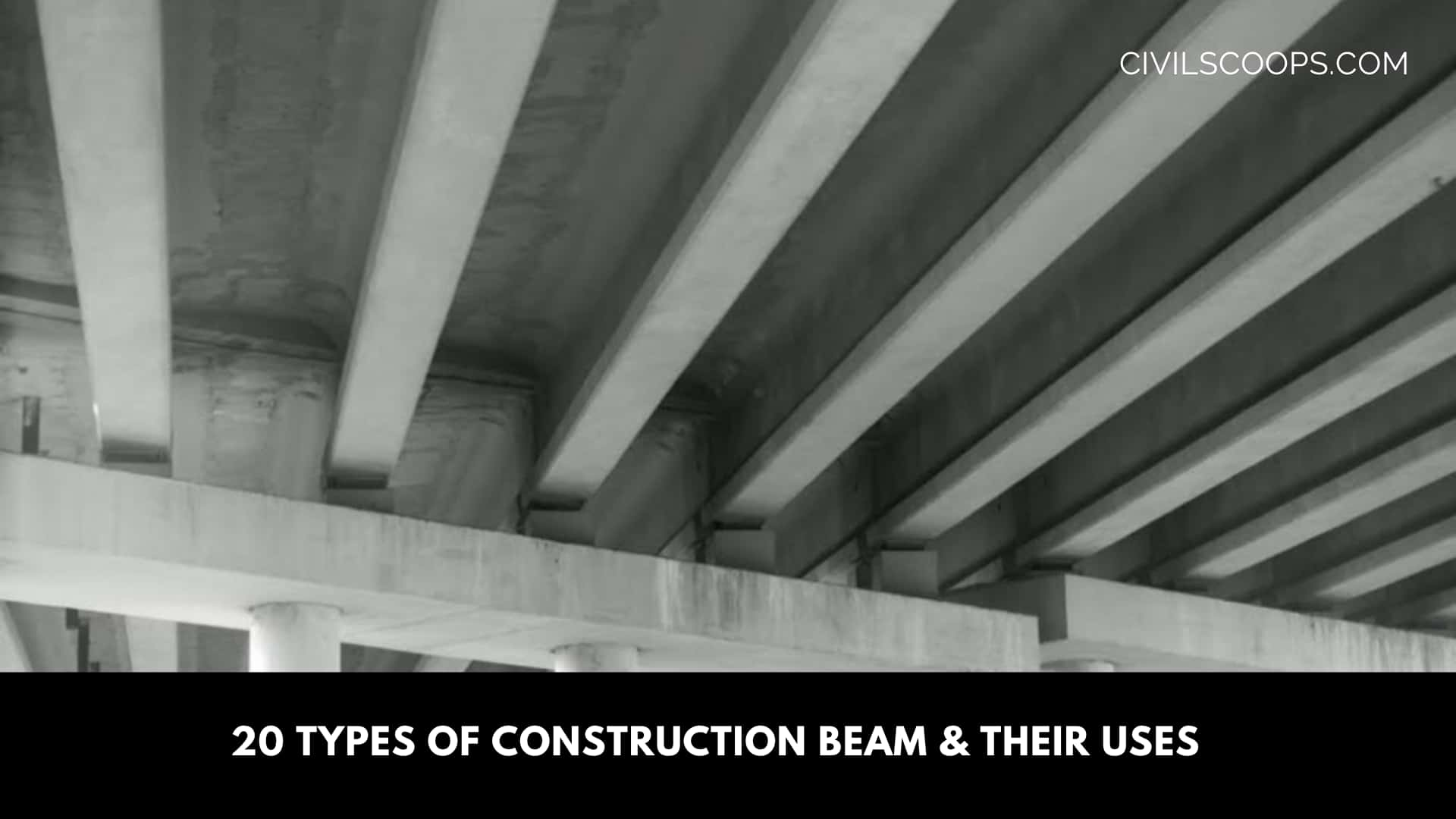
Table of Contents
Introduction of Construction Beams
There are various types of construction beams are used in buildings depending upon their function and the nature of work. Beams are generally constructed to support one or more points and the effective length of the beam between two supports is known as the span of the Beam.
The Beam is basically a horizontal structural element that is constructed to support the slab and withstand the loads coming from the building. The Beam is connected to the columns to which it transmits the total load up to the foundation.
In this article, you will get to know about the Types of Construction Beams & their uses.
Types of Construction Beams

Beams are classified into various types according to their nature which are as follows.
Classification of the beam based on the construction material used
Classification of beams according to the support conditions
- Simply supported Beam
- Continuous beam
- Fixed beam
- Cantilever beam
- Overhanging beam
- Double overhanging beam
Classification of the beam according to Geometry
- Straight beam
- Curved beam
- Tapered beam
Classification according to the method of construction used
- Prestressed concrete beams
- Precast concrete beam
- In situ cast beams
Classification of beams according to the equilibrium condition
- Statically determinate beams
- Statically Indeterminate beams
Classification of beams according to its cross-examination
- I beam
- T beam
Also Read: 22 Types of Beams | Standard Size of Beams
1. Timber Beam
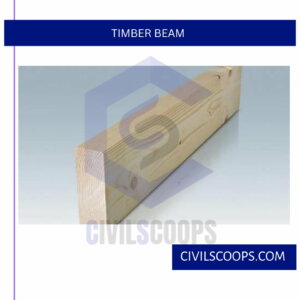
Timber beams are constructed from wood. A timber beam is a structural element that is used in the construction of both vertical columns as well as beams.
The timber beam consists of a single member or built-up member which is constructed from two or more members. The timber beam is designed to resist the bending moment and maximum horizontal shear stress.
Timber beam has very lightweight that’s why it is mostly used in the construction of structures where the dead load should be less. The timber beams are lightweight as compared to the concrete beam and steel beams.
Uses of Timber Beam
- Timber beams are generally used in the olden days for the construction of structures.
- Timber beams have been widely used in regions where wood is available in large quantities.
2. Concrete Beam
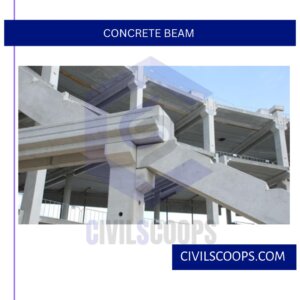
Concrete beams are one of the most widely and commonly used beams in the construction of buildings. The concrete beam is constructed from reinforced cement concrete which can take high compressive stresses.
Concrete beams are constructed to support the loads coming from the slabs and transmit through the column to the foundation.
We know that Concrete is good in compression and weak in tension. That’s why steel reinforcement has used the construction of concrete beams to increase its tensile strength.
Uses of Concrete Beam
- Concrete beams are used to carry vertical as well as horizontal loads. Concrete beams have the ability to resist high compressive loads.
- Concrete beams are used in the construction of bridges, foundations, and various structures.
3. Composite Beam
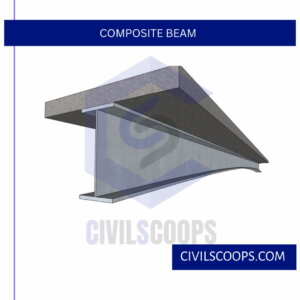
Composite beams at the type of beams that are constructed with the help of two or more materials. Two or more materials are used in the construction of composite beams to increase the strength and stiffness of the beam so that it can carry high loads.
Uses of Composite Beam
- Composite beams have been used in the construction of frame bridges.
- Composite steel and concrete beams are more widely used in which the Steel resists tensile stresses and the concrete resists compressive stresses.
4. Steel Beam
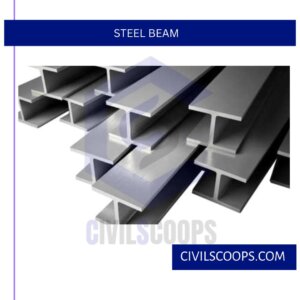
Steel beams are structural beams that are constructed from steel to support heavy loads. Steel beams have high strength and stiffness as compared to concrete beams. Steel beams are constructed in various shapes and sizes and it has different applications.
Uses of Steel Beam
- Steel beams are generally used in the construction of steel structures, workshops, Steel roofs, trusses, bridges, etc.
5. Simply Supported Beam
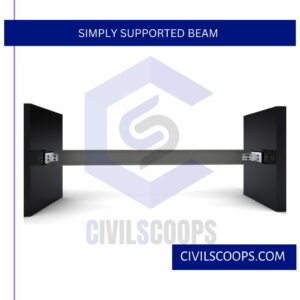
A simply supported beam is defined as the type of beam which is supported at both ends. The simply supported beam is freely supported on the walls are columns at both ends.
This type of beam allows the horizontal movement of the beam and generally undergoes both shear stresses as well as bending moments.
Uses of Simply Supported Beam
- Simply supported beams are widely used in the construction of residential buildings.
6. Continuous Beam
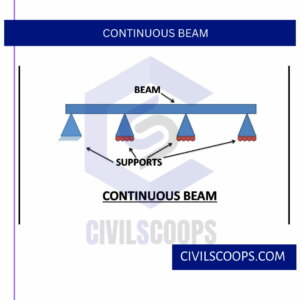
The continuous beam is a type of beam that is supported by more than two supports. In the case of the continuous beam, the end support of the continuous beam may be simply supported or fixed. Continuous beams have more stability as compared to other types of construction beams.
Uses of Continuous Beam
- The continuous beam is generally used in the construction of large-span bridges whose length is too long.
- Continuous beams are also used while constructing long-span slab and structures which has more than two supports in a continuous manner.
7. Fixed Beam

The Fixed-beam is defined as the type of construction beam whose both ends are fixed rigidly in the walls or any other structure. The Fixed-beam cannot be able to rotate at its end.
The Fixed-beam does not allow movement in the vertical direction and the rotation of the beam. The fixed beam only undergoes shear stresses and there is no moment is produced at the end of the fixed beam.
Uses of Fixed Beam
- Fixed beams are used in the construction of trusses.
8. Cantilever Beam
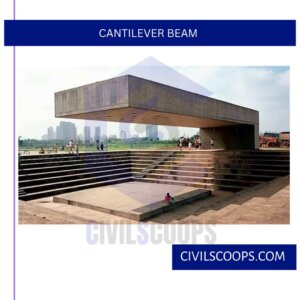
A cantilever beam is a type of construction in which one end of the cantilever beam is fixed and the other end of the cantilever beam is free.
The cantilever beam is constrained at one end with the other end extending freely outwards direction. When the cantilever beam is loaded the beam transfers the load to its fixed end under the action of Bending.
Uses of Cantilever Beam
- Cantilever beams are used in the construction of balconies Cantilever slabs etc.
9. Overhanging Beam

Overhanging beams are defined as the types of construction beams whose end portion of the beam extends beyond the supports. The properties of the overhanging beams are the same as the cantilever beam and simply supported Beams.
The overhanging beams are classified into two types such as overhanging beams on the right side and overhanging beams on the left side.
The beam whose end portion extends beyond the supports on the right side is known as the overhanging beam on the right side.
The beam whose end portion extends beyond the supports in the left direction is known as the overhanging beam on the left side.
Uses of Overhanging Beam
- An overhanging beam is used where it is not practical to provide support to the beam at one end.
- You will frequently encounter overhanging beams in a floor beam that extends beyond the exterior wall of a building to support a balcony.
- It is also used to support roof extensions as in the picture below.
10. Double Overhanging Beam

A double overhanging beam is a type of construction beam whose both ends extend beyond its supports.
11. Straight Beam
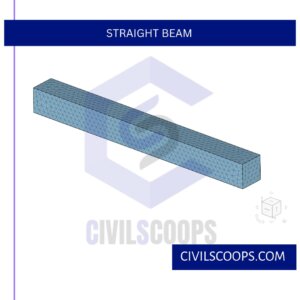
Straight beams are the type of construction beams which has a straight profile. The straight beam has an equal cross-section area throughout the length of the beam.
Uses of Straight Beam
- Beams are the horizontal members used to support vertically applied loads across an opening.
- In a more general sense, they are structural members that external loads tend to bend or curve.
12. Curved Beam
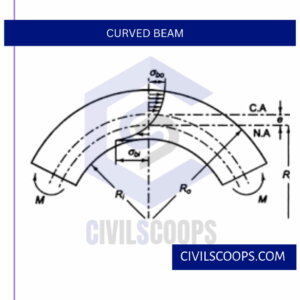
The curved beam is a type of construction beam boots shape is curved and the center of gravity of the curved beam always follows a curve.
Uses of Curved Beam
- The curved beam is used for the construction of decorative structures or buildings.
13. Tapered Beam
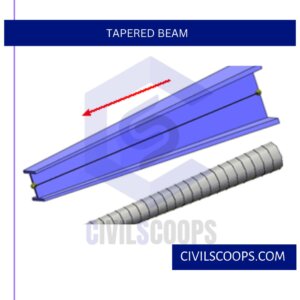
The type or beam is a type of construction beam that is wider at the support and tapered at its end. Generally, cantilever beams are constructed in Tapered form because the moments are developed at end supports only.
Uses of Tapered Beam
- Tapered beam framing can be used to create offices, retail, or other commercial space as well as warehouses up to 120 feet wide.
- Tapered rafter beams are paired with straight wall columns, simplifying the installation of straight interior walls.
14. Prestressed Concrete Beam

In the case of prestressed concrete beams, the stresses are induced during their construction on site that’s why it is known as prestressed concrete beams. Prestressed concrete beams are more stable and can carry higher stresses as compared to conventional concrete beams.
Uses of Prestressed Concrete Beam
- It is now commonly used for floor beams, piles, and railways sleepers, as well as structures such as bridges, water tanks, roofs, and runways.
- Generally, prestressed concrete is not necessary for columns and walls, however, it can be used economically for tall columns and high retaining walls with high bending stresses.
15. Precast Concrete Beam
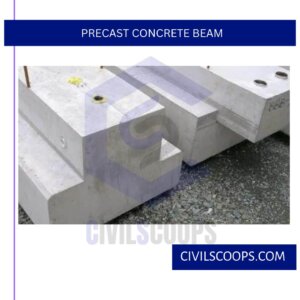
Precast concrete beams are also popularly known as cast-in-situ beams which are constructed at the factory as per the required size and specifications.
Precast concrete beams are constructed in the factory itself which is away from the construction site. The construction of the precast concrete beams is done under a controlled environment and supervision.
Uses of Precast Concrete Beam
- Precast concrete beams are generally used where fast construction is required so that precast concrete beams are used.
16. In-Situ Cast Beam

Cast-in-place concrete, also known as poured-in-place, is a concreting technique that is undertaken in situ or in the concrete component’s finished position. Cast-in-place concrete is the preferred choice for concrete slabs and foundations, as well as components such as beams, columns, walls, roofs, and so on.
Uses of In-Situ Cast Beams
- Cast in situ concrete is appropriate for all types of basement construction. It is a common form of basement construction for residential use, due to its relatively simple application, adaptability, and cost.
17. Statically Determinate Beam
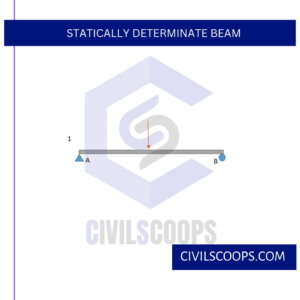
Statically determinate beams are defined as beams that can be analyzed by using basic equilibrium conditions. The support reactions which are developed in these beams can be calculated with the help of basic equilibrium conditions.
The condition which is used to analyze the statically determinate beam is the summation of all the horizontal forces equal to zero. The summation of all vertical forces and all moments is zero.
The simply supported beam and cantilever beams are examples of statically determinate beams.
Uses of Statically Determinate Beam
- Simply supported beams, cantilever beams, single and double overhanging beams, three-hinged arches, etc.
18. Statically Indeterminate Beam

Statically indeterminate beams are defined as beams that cannot be analyzed with the help of basic equilibrium conditions.
The end reactions which develop in the case of statically determinate beams are calculated by using the Strain energy method. The stresses in the statically indeterminate beams are less as compared to the statically determinate beams.
Uses of Statically Indeterminate Beams
- Statically indeterminate structures are fixed beams, continuous beams, fixed arches, two-hinged arches, portals, multistoried frames, etc.
19. I Section Beam
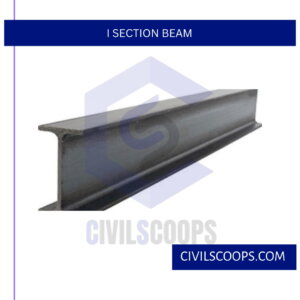
I beam are one of the commonly used beams in the construction of steel structures. I beam has a greater moment of inertia due to which it has high resistance to the deflection and the bending moment.
I-section beams are manufactured in the factory with the help of steel. I section consists of the top flange, web, and bottom flange.
Uses of I Section Beam
- They are often used as critical support trusses, or the main framework, in buildings. Steel I beams ensure a structure’s integrity with relentless strength and support.
20. T Section Beam
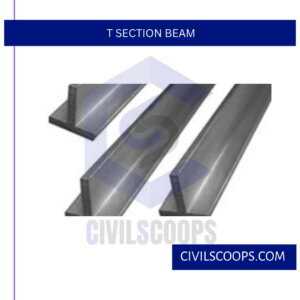
A T–beam (or tee beam), used in construction, is a load-bearing structure of reinforced concrete, wood, or metal, with a T-shaped cross-section. The top of the T-shaped cross-section serves as a flange or compression member in resisting compressive stresses. Done properly, the slab acts as the compression flange.
Uses of T Section Beam
- These types of beams are widely used in the construction of steel structures.
[su_box title=”FAQ” style=”default” box_color=”#333333″ title_color=”#FFFFFF” radius=”3″ class=”” id=””]
Types of Beams in Construction
The Different Types of Beams
- Universal beam.
- Hip beam.
- Trussed beam.
- Lattice beam.
- Composite beam.
- Chilled beam.
- Reinforced concrete beam.
- Steel beam.
What Is Cantilever Beam?
A cantilever is a rigid structural element that extends horizontally and is supported at only one end. Typically it extends from a flat vertical surface such as a wall, to which it must be firmly attached. Like other structural elements, a cantilever can be formed as a beam, plate, truss, or slab.
What Is Concrete Beam?
Concrete beams, also known as summers, are girders, which take up a load of a floor or wall and relay it to other structural components. The load capacity and/or span of a ceiling can be increased by the use of beams.
What Is Composite Beam?
Composite beams are constructed from more than one material to increase stiffness or strength (or to reduce cost). Common composite-type beams include I-beams where the web is plywood and the flanges are solid wood members (sometimes referred to as “engineered I-beams”).
What Is Steel Beam?
A steel beam is a structural element that basically opposes loads applied along the side to the beam’s axis. Its method of redirection is fundamentally by twisting. The loads applied to the beam bring about response forces at the beam’s support points.
What Is Simply Supported Beam?
A simply supported beam is one that rests on two supports and is free to move horizontally. Typical practical applications of simply supported beams with point loadings include bridges, beams in buildings, and beds of machine tools.
What Is Continuous Beam?
A continuous beam, i.e. a beam that has more than two supports, is statically indeterminate. The reactions in the supports of a continuous beam cannot be obtained with the equations of static equilibrium only. For the calculation of the reactions in the supports, each section is considered an independent beam.
What Is Fixed Beam?
A fixed beam is supported between two fixed ends. It is also called a fixed-end beam or built-in beam or restrained beam. It is classified as a statically indeterminate beam, which involves more than three unknowns and the equilibrium equations of statics alone are not sufficient to determine the support reactions.
What Is Overhanging Beam?
If the end portion of a beam extends beyond the support, then the beam is known as overhanging beam. Overhanging may be on one of the supports or on both sides.
How Much Steel Beam Cost?
Steel I-beams cost between $6 and $20 per foot on average before shipping and installation. They are one of the most popular beams used in the construction industry.
Types of Composite Beams
- Flange.
- Deflection.
- Fiber-Reinforced Polymer.
- Concrete Slab.
- Engineered Cementitious Composite.
- Shear Connector.
- Steel Beam.
I Section Beam
In the construction industry I-beams are used as cross sections providing strength to girders, it also provides support to joists which in turn support ceilings and/or floors. They are also widely used in the construction industry as support for buildings to ensure that the structure is strong enough.
In Situ Concrete Beams
Many structures (e.g. buildings, and bridges) require the construction of beams in situ. Generally, these will be supported by walls or columns though sometimes they will be ground-supported. Construction of a beam will require formwork (see also ‘Formwork’) for its sides and soffit.
Prestressed Concrete Beam
Prestressed concrete is a form of concrete used in construction. It is substantially “prestressed” during production, in a manner that strengthens it against tensile forces which will exist when in service.
What Is Curved Beam?
A beam whose axis is not straight and is curved in elevation is said to be a curved beam. If the applied loads are along the y direction and the span of the beam is along the x direction, the axis of the beam should have a curvature in the x-y plane.
Straight Beam
Straight beam testing is generally employed to find cracks or delaminations parallel to the surface of a test piece, as well as voids and porosity. It may use contact, delay line, dual element, or immersion transducers, all of which launch longitudinal waves on a straight path into the test piece.
[/su_box]
[su_note note_color=”#F2F2F2 ” text_color=”#333333″ radius=”3″ class=”” id=””]
Like this post? Share it with your friends!
Suggested Read –
- 10 Construction Certifications and Where to Get Them
- What Is Hardened Concrete | Properties of Hardened Concrete
- What Is Plaster | Types of Plaster As Per Material | Defects In Plastering
- What Are Hollow Bricks | Advantage of Hollow Bricks | Disadvantage of Hollow Bricks | Sizes of Bricks Blocks | How to Make Hollow Bricks
- What Is Fire Escape Staircases | Types of Fire Escaping Stairs | What Is the Importance of Fire Escape in the Building | What Are the Fire Staircase Requirements
[/su_note]
Originally posted 2023-03-21 11:00:37.
